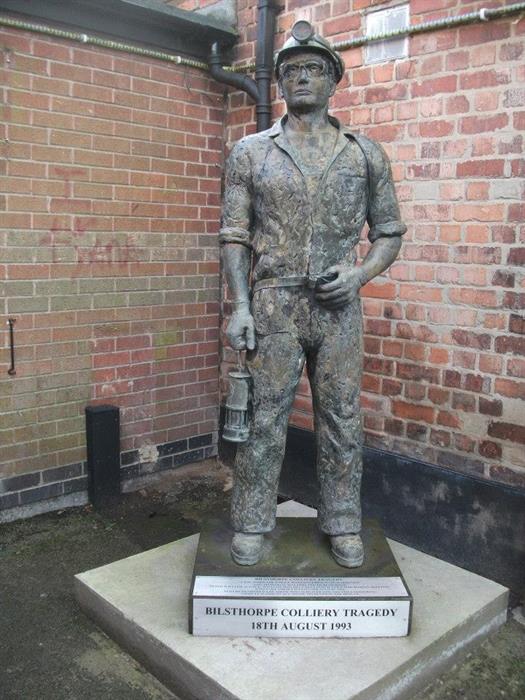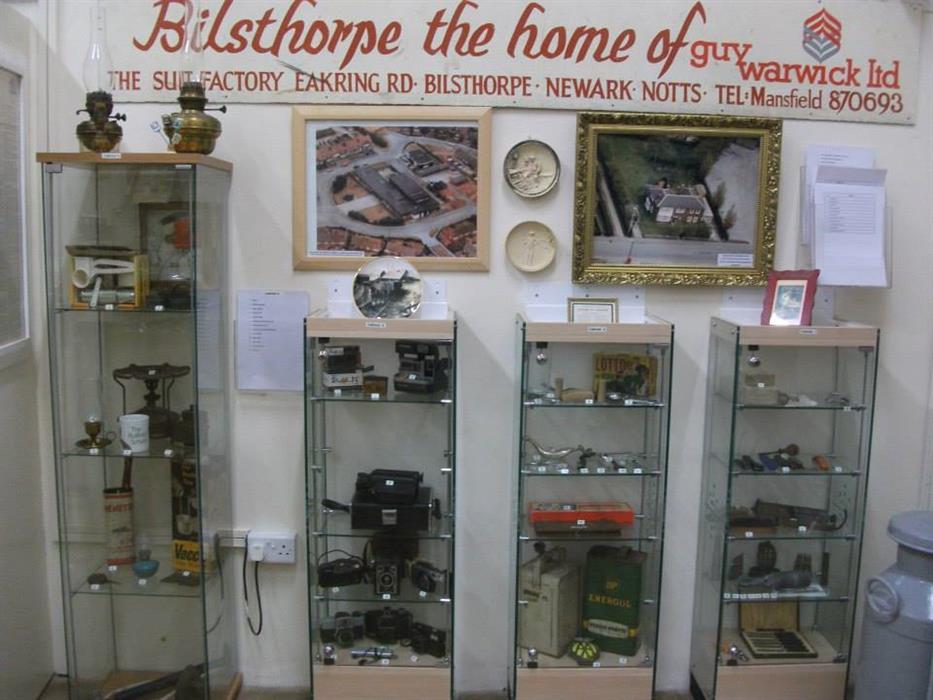In love-local
Experience Nottinghamshire's Business Development Manager Jayne on her visit to the Bilsthorpe Heritage Museum.
Nottinghamshire has always been a county that not only embraces its heritage but celebrates it, shouting from the rooftops at every opportunity. Whether it’s majestic stately homes or gritty stories of rebels and endurance, the good people of Nottinghamshire rise to the challenge and in a small corner of North Nottinghamshire, the Bilsthorpe Heritage Museum continues to grow and welcomes visitors from far and wide.
In the centre of the village and adjacent to the village hall, the old village squash courts became home to the Bilsthorpe Heritage Museum in 2014. It is a treasure trove of mining and historical artefacts, telling stories of the harsh realities of life at the coal face and exhibiting hundreds of individual pieces of mining related items that have been lovingly cared for over the years and offered to the museum so they can be shared with the public. Some items have also been bid for in auctions and this amazing not for profit attraction lovingly displays all pieces either in cabinets or on racks and stands so that you can pick them up and connect with a piece of history. I was encouraged to try on the miners helmet, self rescuer & battery pack plus the pick axe and shovel – then imagine making my way 1500 feet down into the mine for a 7.25 hour shift in temperatures of 100+ degrees – it’s actually impossible to imagine in all honesty. Bilsthorpe Colliery started producing coal in 1927 and this museum charts the following 70 years, including records of all colliery workers, models of mining equipment and pieces of history rescued from dusty attics, garages and cupboards all over the world.
Highlights for me included the rack of riding checks – tokens with each employees unique number which they took when clocking on for a shift and handed back – god willing – at the end of the shift. This helped identify anyone missing incase of an incident plus each worker could find a red, yellow, green or blue token on their peg which meant that the worker had been summoned for a meeting with a particular department. A beautifully renovated Bilsthorpe National Union of Mineworkers banner catches your eye the moment you walk into the room, along with compelling images and wonderful original signage. Miners lamps, safety and rescue equipment, the original bars of soap taken by the miners at the end of the shift, coal – of course – and artefacts fill the room and you will remember sobering memorials to those that lost their life whilst working in the mine long after you’ve left the museum. For the uninitiated novices like me, there’s plenty of information available as you make your way around the room and the wonderful volunteers (most of whom worked in the mine) are full of detail and anecdotes, swapping stories with other volunteers about life at the coal face. Whilst it was undoubtedly a tough and punishing job, there is a tangible camaraderie amongst the former workmates whose lives have been shaped and defined by Bilsthorpe Colliery. Ask them anything and one of them will know the answer, memories etched in their minds to the point where they can still throw around names and riding check numbers as though it were only yesterday. Special thanks to Alan for being an absolute star, imparting his knowledge and bringing the museum alive and a special thank you to Eric, one of the museum’s original founders – an astonishing memory for detail and a heart-warming twinkle in his eye!
Bilsthorpe Colliery started producing coal in 1927 and this museum charts the following 70 years, including records of all colliery workers, models of mining equipment and pieces of history rescued from dusty attics, garages and cupboards all over the world.
Highlights for me included the rack of riding checks – tokens with each employees unique number which they took when clocking on for a shift and handed back – god willing – at the end of the shift. This helped identify anyone missing incase of an incident plus each worker could find a red, yellow, green or blue token on their peg which meant that the worker had been summoned for a meeting with a particular department. A beautifully renovated Bilsthorpe National Union of Mineworkers banner catches your eye the moment you walk into the room, along with compelling images and wonderful original signage. Miners lamps, safety and rescue equipment, the original bars of soap taken by the miners at the end of the shift, coal – of course – and artefacts fill the room and you will remember sobering memorials to those that lost their life whilst working in the mine long after you’ve left the museum. For the uninitiated novices like me, there’s plenty of information available as you make your way around the room and the wonderful volunteers (most of whom worked in the mine) are full of detail and anecdotes, swapping stories with other volunteers about life at the coal face. Whilst it was undoubtedly a tough and punishing job, there is a tangible camaraderie amongst the former workmates whose lives have been shaped and defined by Bilsthorpe Colliery. Ask them anything and one of them will know the answer, memories etched in their minds to the point where they can still throw around names and riding check numbers as though it were only yesterday. Special thanks to Alan for being an absolute star, imparting his knowledge and bringing the museum alive and a special thank you to Eric, one of the museum’s original founders – an astonishing memory for detail and a heart-warming twinkle in his eye!
 Making such a success of lovingly creating the mining exhibition has led to the museum being sent other historical artefacts too so do make sure you visit other parts of the Heritage Museum where farming and photography equipment, retro matchboxes, hot water bottles, wooden washing dollys and mangles amongst other items are all displayed. I saw the store room and it’s overflowing with recently donated pieces which, once restored, will ensure that this museum continues to be a treasure trove for all who visit. There’s tea and coffee available plus some homemade gifts on sale – all profits go towards keeping this lovely piece of history open and available to all.
And before you leave the village, do stop by gardens at the back of the hall by the Post Office and pay your respects to a second memorial, erected in 2011.The eight-foot sandstone Davy lamp was designed by local school children and created in recognition of those who died at Bilsthorpe pit between 1927 and 1997 and carved into the sculpture are the names of those 76 men and one woman. The museum and memorial are a fitting tribute and ensure that those who worked in the pit and those who lost their lives are remembered and celebrated.
Making such a success of lovingly creating the mining exhibition has led to the museum being sent other historical artefacts too so do make sure you visit other parts of the Heritage Museum where farming and photography equipment, retro matchboxes, hot water bottles, wooden washing dollys and mangles amongst other items are all displayed. I saw the store room and it’s overflowing with recently donated pieces which, once restored, will ensure that this museum continues to be a treasure trove for all who visit. There’s tea and coffee available plus some homemade gifts on sale – all profits go towards keeping this lovely piece of history open and available to all.
And before you leave the village, do stop by gardens at the back of the hall by the Post Office and pay your respects to a second memorial, erected in 2011.The eight-foot sandstone Davy lamp was designed by local school children and created in recognition of those who died at Bilsthorpe pit between 1927 and 1997 and carved into the sculpture are the names of those 76 men and one woman. The museum and memorial are a fitting tribute and ensure that those who worked in the pit and those who lost their lives are remembered and celebrated.
You can follow @BilsHeritage on Twitter and check our website to keep up to date with the museum's news and events.
 Bilsthorpe Colliery started producing coal in 1927 and this museum charts the following 70 years, including records of all colliery workers, models of mining equipment and pieces of history rescued from dusty attics, garages and cupboards all over the world.
Highlights for me included the rack of riding checks – tokens with each employees unique number which they took when clocking on for a shift and handed back – god willing – at the end of the shift. This helped identify anyone missing incase of an incident plus each worker could find a red, yellow, green or blue token on their peg which meant that the worker had been summoned for a meeting with a particular department. A beautifully renovated Bilsthorpe National Union of Mineworkers banner catches your eye the moment you walk into the room, along with compelling images and wonderful original signage. Miners lamps, safety and rescue equipment, the original bars of soap taken by the miners at the end of the shift, coal – of course – and artefacts fill the room and you will remember sobering memorials to those that lost their life whilst working in the mine long after you’ve left the museum. For the uninitiated novices like me, there’s plenty of information available as you make your way around the room and the wonderful volunteers (most of whom worked in the mine) are full of detail and anecdotes, swapping stories with other volunteers about life at the coal face. Whilst it was undoubtedly a tough and punishing job, there is a tangible camaraderie amongst the former workmates whose lives have been shaped and defined by Bilsthorpe Colliery. Ask them anything and one of them will know the answer, memories etched in their minds to the point where they can still throw around names and riding check numbers as though it were only yesterday. Special thanks to Alan for being an absolute star, imparting his knowledge and bringing the museum alive and a special thank you to Eric, one of the museum’s original founders – an astonishing memory for detail and a heart-warming twinkle in his eye!
Bilsthorpe Colliery started producing coal in 1927 and this museum charts the following 70 years, including records of all colliery workers, models of mining equipment and pieces of history rescued from dusty attics, garages and cupboards all over the world.
Highlights for me included the rack of riding checks – tokens with each employees unique number which they took when clocking on for a shift and handed back – god willing – at the end of the shift. This helped identify anyone missing incase of an incident plus each worker could find a red, yellow, green or blue token on their peg which meant that the worker had been summoned for a meeting with a particular department. A beautifully renovated Bilsthorpe National Union of Mineworkers banner catches your eye the moment you walk into the room, along with compelling images and wonderful original signage. Miners lamps, safety and rescue equipment, the original bars of soap taken by the miners at the end of the shift, coal – of course – and artefacts fill the room and you will remember sobering memorials to those that lost their life whilst working in the mine long after you’ve left the museum. For the uninitiated novices like me, there’s plenty of information available as you make your way around the room and the wonderful volunteers (most of whom worked in the mine) are full of detail and anecdotes, swapping stories with other volunteers about life at the coal face. Whilst it was undoubtedly a tough and punishing job, there is a tangible camaraderie amongst the former workmates whose lives have been shaped and defined by Bilsthorpe Colliery. Ask them anything and one of them will know the answer, memories etched in their minds to the point where they can still throw around names and riding check numbers as though it were only yesterday. Special thanks to Alan for being an absolute star, imparting his knowledge and bringing the museum alive and a special thank you to Eric, one of the museum’s original founders – an astonishing memory for detail and a heart-warming twinkle in his eye!
 Making such a success of lovingly creating the mining exhibition has led to the museum being sent other historical artefacts too so do make sure you visit other parts of the Heritage Museum where farming and photography equipment, retro matchboxes, hot water bottles, wooden washing dollys and mangles amongst other items are all displayed. I saw the store room and it’s overflowing with recently donated pieces which, once restored, will ensure that this museum continues to be a treasure trove for all who visit. There’s tea and coffee available plus some homemade gifts on sale – all profits go towards keeping this lovely piece of history open and available to all.
And before you leave the village, do stop by gardens at the back of the hall by the Post Office and pay your respects to a second memorial, erected in 2011.The eight-foot sandstone Davy lamp was designed by local school children and created in recognition of those who died at Bilsthorpe pit between 1927 and 1997 and carved into the sculpture are the names of those 76 men and one woman. The museum and memorial are a fitting tribute and ensure that those who worked in the pit and those who lost their lives are remembered and celebrated.
Making such a success of lovingly creating the mining exhibition has led to the museum being sent other historical artefacts too so do make sure you visit other parts of the Heritage Museum where farming and photography equipment, retro matchboxes, hot water bottles, wooden washing dollys and mangles amongst other items are all displayed. I saw the store room and it’s overflowing with recently donated pieces which, once restored, will ensure that this museum continues to be a treasure trove for all who visit. There’s tea and coffee available plus some homemade gifts on sale – all profits go towards keeping this lovely piece of history open and available to all.
And before you leave the village, do stop by gardens at the back of the hall by the Post Office and pay your respects to a second memorial, erected in 2011.The eight-foot sandstone Davy lamp was designed by local school children and created in recognition of those who died at Bilsthorpe pit between 1927 and 1997 and carved into the sculpture are the names of those 76 men and one woman. The museum and memorial are a fitting tribute and ensure that those who worked in the pit and those who lost their lives are remembered and celebrated.
You can follow @BilsHeritage on Twitter and check our website to keep up to date with the museum's news and events.
Related
0 Comments
Comments
Comments are disabled for this post.

 to add an item to your Itinerary basket.
to add an item to your Itinerary basket.










